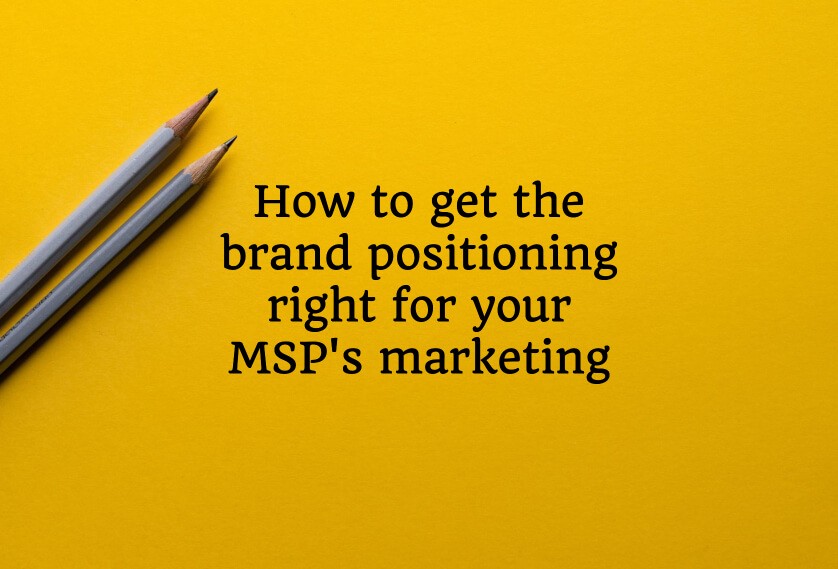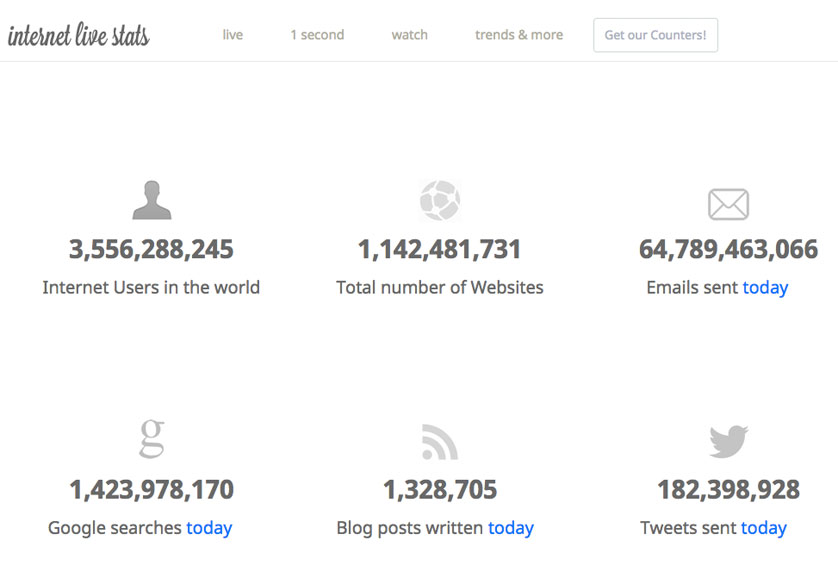Getting the positioning right is a one off MSP marketing task. Here's what to do and how to do it
People are more likely to judge your MSP based on what they feel about it, than what they know about it. Us humans are funny emotional creatures, and we can’t help but be driven by our emotions.
When it comes to making a considered buying decision (something you think about, such as picking a new IT support company) most people unwittingly let their heart make the decision for them. And then they use their brain to justify the decision.
You might be thinking that you have never done this… but you probably do it all of the time. Men do when they buy gadgets, technology and cars. Women do with clothes and jewellery.
As a business owner, the good news is that you can affect this decision-making process amongst your prospects, by getting your reputation right. There’s no mystery to this, just a series of actions to take.
The theory
Your positioning is how people think about your MSP. When it comes to positioning, perception is reality. You might be the best IT support business in town… but if some people think that you are awful, then that’s their reality. The trick is to make sure that the majority of people think about your business the right way.
There are a number of different factors that affect the way they think about you and your positioning.
Your brand
Your brand is not your business’s name or logo. Nor is it you or your staff. Sadly, your brand is not as tangible as that. Your brand is the emotional and psychological relationship you have with your clients and prospects.
What that means is the emotional reaction someone has when they come into contact with your business.
Look around you now. What logos do you see? Maybe you see the logo of your computer or phone. Let’s say you’ve got an Apple device… what do you feel about Apple? Perhaps you can see the logos on boxes of some of the devices you sell. When you see a certain company’s logo what do you feel?
However you feel, that’s the brand. If you look at a logo and think “cheap and nasty” then that’s the brand to you. Typically, well-built brands mean the same thing to most people. When the majority of people look at the Apple logo, they have very positive thoughts – so positive in fact that Apple is considered to be the world’s most valuable brand. The products it makes are only a part of the overall experience.
Please don’t think that a brand is just about the logo. It’s so much more than that. The logo just represents your brand.
How important is building a brand for most independent IT support or IT consultancy businesses? Realistically… not that important.
Let me qualify that. Yes, having a strong brand is important. But there are so many other marketing activities that you could do that would make a bigger difference to the business, faster.
You see, building a brand is a long-term activity that is happening right now whether you are working on it or not. Just being in business means you build a brand in the minds of your clients and prospects.
But because it’s a long-term thing, it doesn’t get clients in today. Having a great brand where everyone thinks you are best IT support business in town is no use to you if your order book is empty.
And since most business owners don’t spend enough time on marketing; the time you do have to spend on growing your business should really be invested into activities that generate new clients; get existing clients to buy again, and increase average spend.
If you only have a few hours a week to spend on marketing, don’t worry about the brand. Focus on generating new leads. On tightening up your client retention. On making your consultants and technicians better sales people.
Your back story
A back story is your story, or your business’s story, of how you got to where you are today.
This should not be a turgid account of facts and dates (“we established the business in 1972 as a one man band. In 1981 we then moved to such-and-such building down the road” etc). This is boring and only of interest to you and your family!
A powerful back story is a carefully put-together tale, created in such a way that it triggers an emotional reaction in your clients and prospects.
Let me give you an example: You’ve heard of Stelios, right?
Stelios Haji-Ioannou, the founder of EasyJet, is a British entrepreneur with Cypriot roots.
He’s the son of a wealthy ship-owner. In the early 90s his father gave him £30 million to set up a shipping business (Stelmar Shipping) which he later sold for approximately £1 billion. Nice work if you can get it.
The reason Stelios launched EasyJet was based on his experiences of flying around the world. He travelled a lot and had to use the old big airlines.
Every time he was on a plane, Stelios would sit there and think “This is just crazy, I’m being served up food that I don’t want and have had to pay for. I’ve paid £400 for this trip – there should be a budget airline where the earlier you book, the less you pay”.
As a result, Stelios went on to create not just EasyJet, but the entire modern budget airline industry itself.
Now, that’s a real back story because it explains why Stelios was motivated to set up the first modern budget airline. He was frustrated over the way the big airlines were doing things and believed that people shouldn’t have to pay for things that they don’t want.
Your business needs a back story. One that paints a picture in the minds of the reader. One that tells them why they should trust your business.
“Bob Smith is passionate about IT, and has been for as long as he can remember. As a child growing up in Yorkshire, he was fascinated by all sorts of computers and was always tinkering with them. His bedroom was crammed with all sorts of technology as he experimented with computers; constantly pushing the limits.
“It was no surprise to anyone when Bob left school, and announced that he would dedicate his life to helping businesses get the most out of their IT. That was 20 years ago – and today Bob is still in love with IT, computers and technology. He’s the owner and principal of XYZ IT, the leading IT support company in YourTown, with more than 10 highly qualified support technicians”.
Now THAT’S a back story.
Although Stelios was very wealthy before he founded EasyJet, what’s relevant is a man sitting on a plane getting frustrated and thinking “I’d like to do this better”.
And Bob Smith is an IT support expert who thinks “I want to run my own IT support company my way. I’m passionate about the work I do, which is why I want to set up my own business”.
Even if you only opened your business a couple of years ago, you still have a story – unique to you and your particular feelings and motivations.
Key message: The purpose of a back story is to communicate passion. Show a passion for what you do and how you do it, and clients will not be able to resist you.
The cost of your service
This may sound crazy but you should be the most expensive IT support or IT consultancy business in your market. Premium people are attracted to a service they believe to be independent and bespoke and that’s how you should be positioning your business.
The best clients expect to pay more for quality products and great service. By being more expensive you could actually win more business as people will want to be with you, and stay with you.
Thinking outside IT support, some dentists are very good at this. They seem to charge the highest prices, yet they have a waiting list to join their practice and very loyal clients. They do this by offering the highest quality – longer appointments, more equipment, better products.
And so they get the best clients in town who are willing to pay a bit more for the best. They don’t get the low value, hassle clients, who query bills and moan a lot. No-one wants those clients. If you have those people now you need to actively change your business to scare them off, and attract a better quality of client.
One pleasant side effect of charging a little more for a premium service means that your gross profit margins are likely to be higher, giving you a greater chance of better net profit (the money that’s yours to take out of the business, once you’ve paid tax on it).
Your competitors
One spanner to throw in the works is what your competitors are already doing. If you are in a market place with a number of established competitors who are already serving the top end of the local marketplace, you may struggle to break into that market.
Sometimes it’s worth getting a friend to go through your competitors’ websites and do a ring round if necessary, to see what your competitors are offering and charging. Price isn’t everything with positioning but it’s a fair indicator of where a business is pitching itself.
If the top end of the marketplace is all sewn up, you may find it more profitable in the short-term to focus on the middle of the market, and wait for one of the big players to change (such as the ownership changing; always a good time to nip in and steal clients). Business is very fluid, and when you take a long-term view, there is always change coming. You just have to be prepared for it.
Action plan
- Create a back story. If you don’t have a good one, embellish the truth a little (but never out and out lie). Once you have a good back story put it everywhere – on your website and in all your marketing materials. Your back story can define your entire business and give people a reason to do business with you. It’s OK to be the ‘front person’ of the business. Clients won’t automatically expect to deal with you. No-one expects Richard Branson to fly the planes
- Decide what kind of clients you want – top end? Then make sure your marketing, your vehicles, your technicians, your service and your pricing appeals to those clients
- Get a friend to check out your competitors for you. Ideally use a friend who knows nothing about your business or IT support. Then they won’t be influenced by prior knowledge
- Use net profit margins as a way of monitoring your position. Typically, businesses that serve the top end of the market have better profit margins






